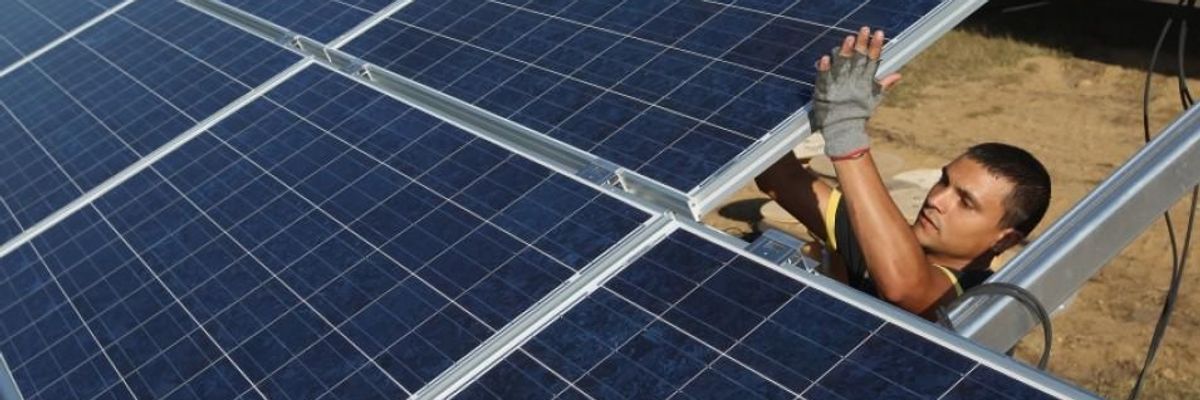Solar is on track to be the "new king" of electricity, the International Energy Agency said in its World Energy Outlook 2020 released Tuesday.
The latest outlook from the IEA notes "the historic nature of the choices" facing global policymakers as they confront the ongoing coronavirus pandemic--which will have "impacts that will be felt for years to come" on the energy sector--and the climate crisis.
The Covid-19 crisis has triggered a 7% drop in CO2 emissions, yet a "decisive" decline in the overall trend of rising emissions isn't on the horizon barring massive and structural changes.
For its outlook, the Paris-based agency analyzed four different scenarios, the most far-reaching being a Net Zero Emissions by 2050 model--which would require "unprecedented contributions" from all stakeholders, including energy companies and governments.
"Renewables take starring roles in all our scenarios, with solar center stage," the agency said in a statement.
Under the "Stated Policies Scenario" [STEPS] described in the report, over the next decade, renewables meet 80% of the global demand for new electricity generation. "This means they overtake coal as the world's largest source of power by 2025, outpacing the 'accelerated case' set out by the agency just a year ago," CarbonBrief noted in its analysis of the new IEA publication.
With sharp cost reductions over the past decade," the IEA states, "solar PV is consistently cheaper than new coal- or gasfired power plants in most countries, and solar projects now offer some of the lowest cost electricity ever seen."
"I see solar becoming the new king of the world's electricity markets. Based on today's policy settings, it is on track to set new records for deployment every year after 2022," said IEA executive director Fatih Birol.
"If governments and investors step up their clean energy efforts in line with our Sustainable Development Scenario [SDS]," said Birol, "the growth of both solar and wind would be even more spectacular--and hugely encouraging for overcoming the world's climate challenge."
Regarding oil, the outlook still shows that "global thirst for the fuel will nonetheless remain large for decades," Axiosreported.
Though the "era of global oil demand growth will come to an end in the next decade," Birol said that "without a large shift in government policies, there is no sign of a rapid decline."
In fact, he continued, "Based on today's policy settings, a global economic rebound would soon push oil demand back to pre-crisis levels."
Calls for global policymakers to "build back better" from the pandemic and work towards a just and green recovery that includes a departure from fossil-fuel based economies have been growing, but widespread pledges to adopt such a climate- and worker-friendly shift have yet to materialize.
As the IEA report put it, "It is too soon to say whether today's crisis represents a setback for efforts to bring about a more secure and sustainable energy system, or a catalyst that accelerates the path of change."
Oil Change International, in its initial analysis of the outlook, welcomed inclusion of a so-called "Net Zero Emissions 2050" scenario for the first time. While noting that inclusion as a step in the right direction, the progressive advocacy group lamented that it was not the main scenario described in the report, a fact it attributed to the agency's fossil fuel bias.
As CarbonBriefnoted, "the NZE2050 case is not a full WEO scenario and so it does not come with the full set of data that accompanies the STEPS and SDS, making it difficult to fully explore the pathway."
According to Hannah McKinnon, director of Oil Change International's Energy Transitions and Futures Program, "A mini 1.5oC scenario (NZE 2050) is a useful step, but until 1.5oC is front and center in the WEO and all IEA tools, the IEA remains a threat to climate safety."
"Limiting warming to 1.5oC is both urgent and possible, but governments and investors alike need pathways that allow them to plan for success, not further entrench fossil fuels," she said, pointing to the NZE2050 scenario as evidence "the IEA is hearing growing demands to be on the right side of history."
"Now," McKinnon continued, "the IEA must take the next big step by making a 1.5oC scenario fully fledged and central in 2021."

